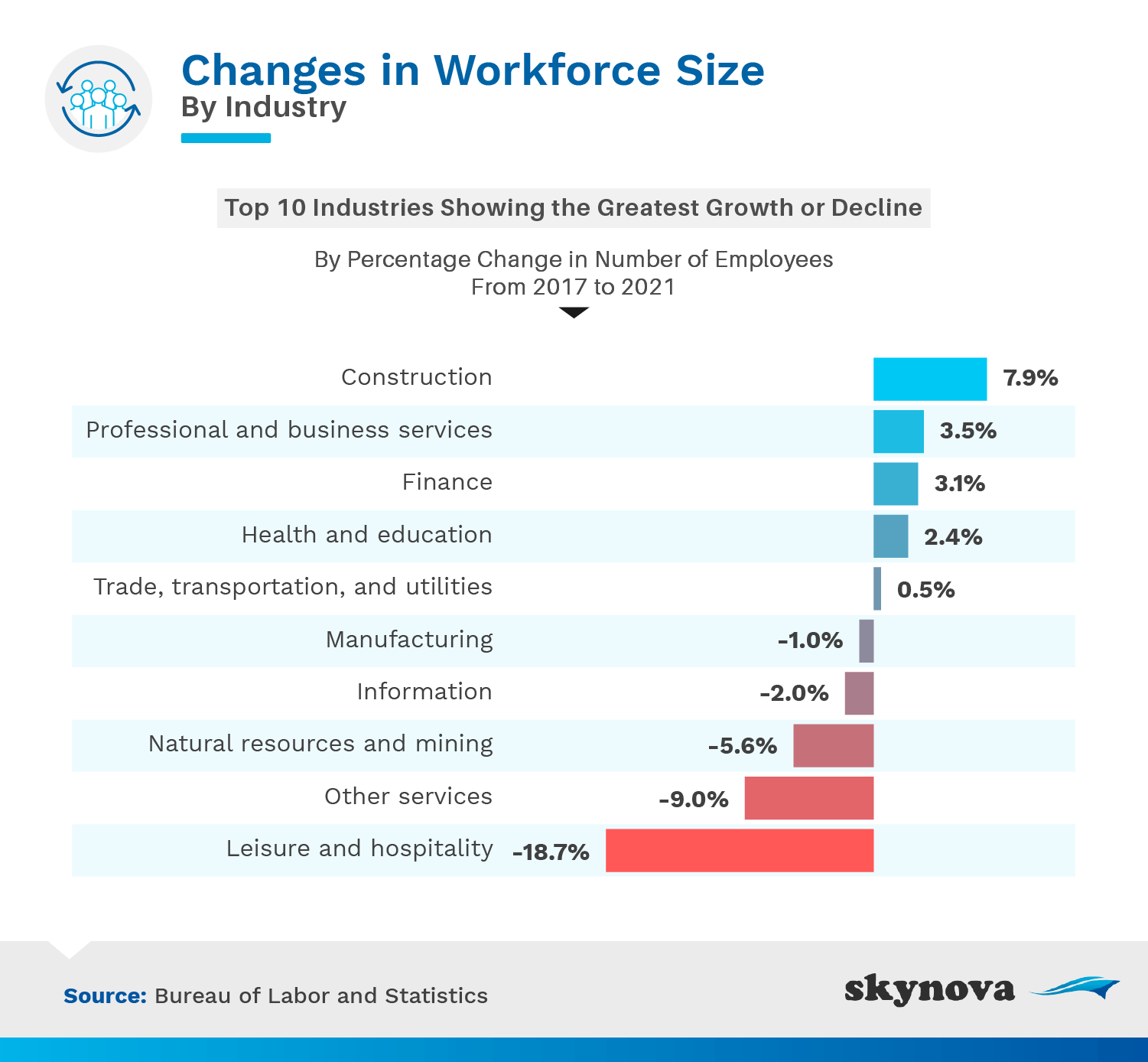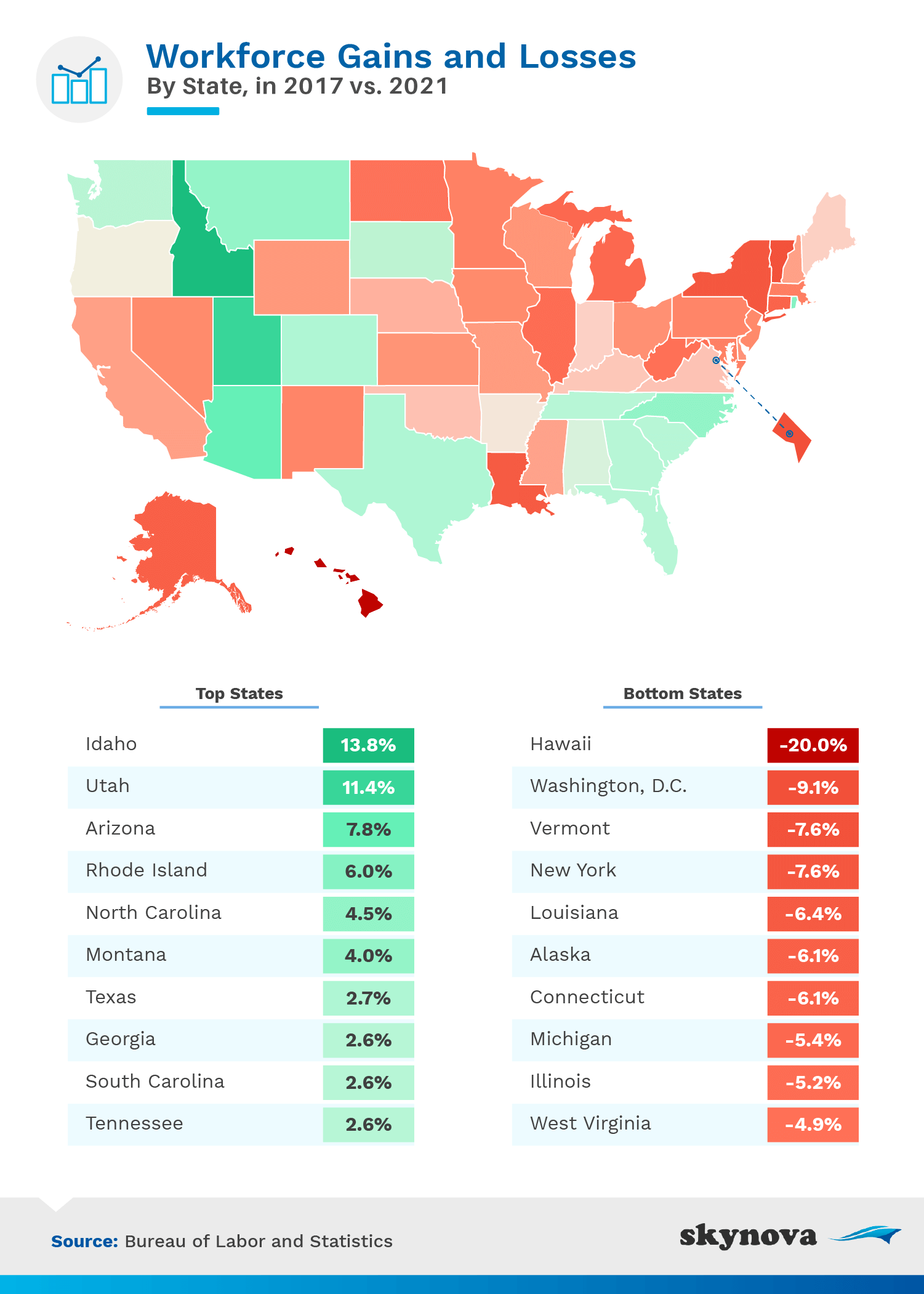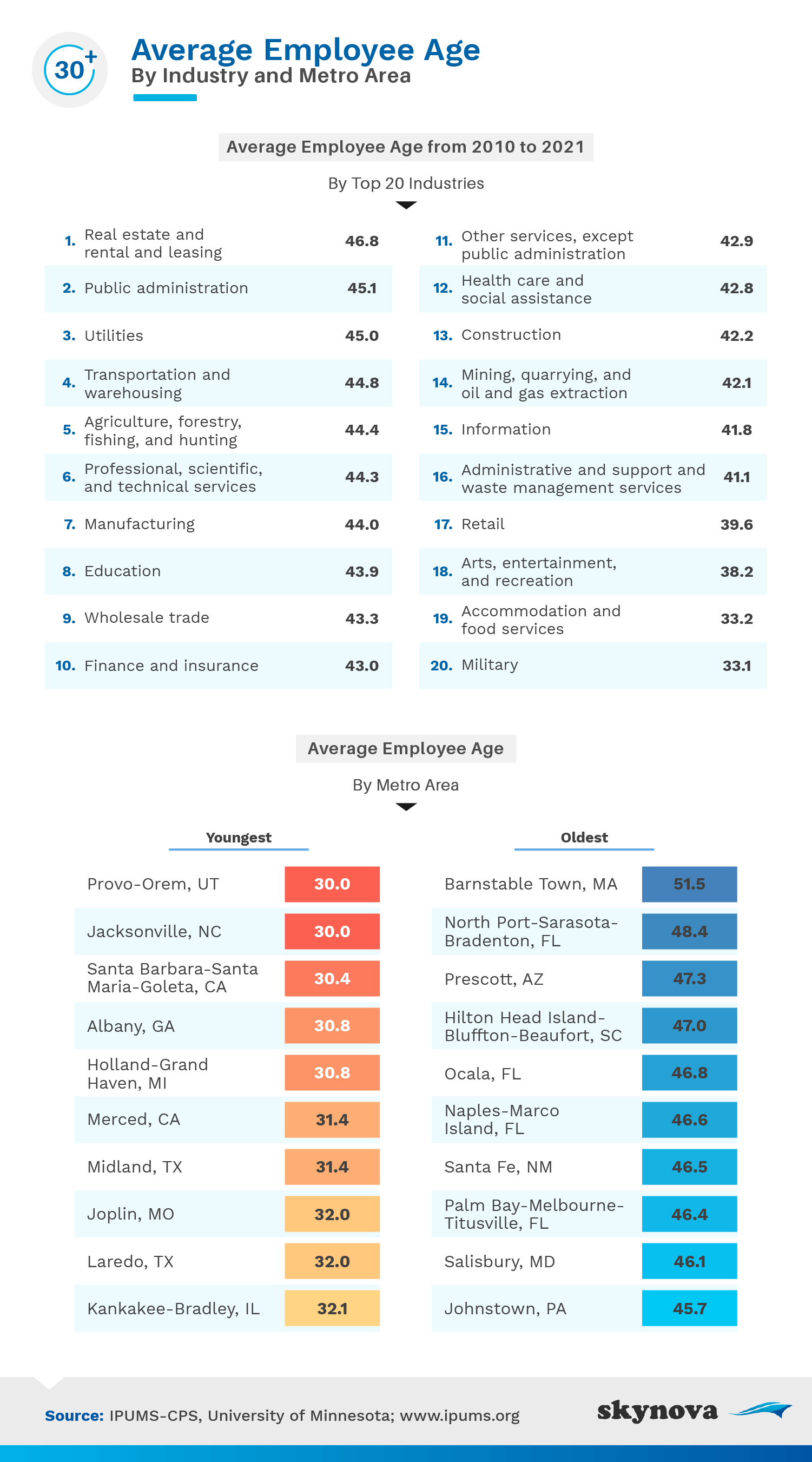
|
In the post-pandemic era, the distribution of the American workforce appears to have changed dramatically. Areas where industries and employees once thrived are relatively desolate in comparison with their former glory days, while previously unpopulated locations have developed into new hot spots for workers. To get a better understanding of when, where, and how industries have developed in particular regions, we collected and analyzed exhaustive IPUMS census data, as well as data from the U.S. Bureau of Labor Statistics (BLS). The results enabled the creation of assets showing the growth and decline of principal American industries, as well as the changes in average employee age per industry.
Utilizing IPUMS census data, the first section of our study looks at the 10 industries that have seen the biggest percentage change in number of employees from 2017 to 2021.

The leisure and hospitality industry suffered a complete nosedive, both in number of employees and annual revenue. In fact, it has been labeled as the industry most heavily impacted by the pandemic. Our research demonstrates an 18.7% decline in the number of leisure and hospitality employees since 2017, with experts insisting the industry has yet to stabilize or show any sign of recovery. Younger participants also demonstrated little to no interest in entering the leisure and hospitality field.
Although IT jobs are on the rise, the information industry as a whole dropped 2%. Many of those losses were in the newsroom.
But not all industries experienced such losses. In fact, the construction industry managed a 7.9% increase in employee numbers since 2017. This can be explained in part by the real estate and housing industry boom, but also signals a more intangible story: one of recovery, resilience, and optimism. Likewise, professional and business services also saw a 3.5% increase in employee numbers.
Taking all industries into account, the next section of our study calculates the workforce gains and losses for each state. Again, employee numbers for 2017 and 2021 were compared.

Some unexpected states are seeing an enormous renaissance in terms of industry and employment growth. Idaho has seen employee numbers increase by nearly 14% since 2017, compared to former industry powerhouses like New York, which saw a 7.6% decline, or Washington, D.C., which lost 9.1% of its workers. Idaho was also the fastest-growing state in terms of overall population in 2020. According to a 2021 survey by the Public Policy Institute of California, nearly nine out of 10 Californians cited housing affordability as a problem, with about one in three people from the highly populated state considering moving because of it. More rural areas like those found in Idaho tend to offer residents much lower costs of living (and more space).
Cost of living is likely a huge factor in these workforce shifts. For example, Hawaii lost more workers than any other state (20%) and is also the single most expensive state. Increasing opportunities for remote work mean workers are no longer tied to one state or city. Instead, they can effectively increase their disposable income at the same job simply by relocating. Research also revealed that people were moving to the growing states for work opportunities related to the construction boom.
The average age of an industry’s employees can reveal a lot about where it’s headed, with a younger workforce often indicating that it will be a focus of the future. This asset reveals the average employee age of America’s most popular industries as well as the average ages of those specialized workforces by metro area.

Real estate is clearly enjoying an enormous boom, but younger workers appear to shy away from related employment opportunities. Those working in real estate were older (46.8 years), on average, than any other workforce. Being a realtor has historically been a career choice for older people, and evidently this trend continues.
Public administration officials came in second in terms of oldest average age, at 45.1 years. Both the entire senate and the president are currently older than any other in U.S. history. Meanwhile, the military (average age 33.1) is younger than any other U.S. industry studied.
Next, we look at the industries that saw the highest percentage of employees unable to work specifically because of the pandemic.

While it’s difficult to imagine an industry that was completely untouched by COVID-19, it’s easy to understand why establishments such as bowling alleys and billiard/pool parlors took the largest hit in terms of the percentage of employees unable to work (61%). These activities all involve the touching of communal objects, which became a big no-no during the pandemic. An industry famous for the use of a shared object, in this case, a basketball - the NBA - was one of the first to bar its employees from playing during the pandemic.
Taxicab services lost more than half (53%) of their workers. While taxi drivers don’t often have to touch any shared objects (other than perhaps a credit card) they are required to share a small, enclosed space with their passengers. This may have led to employees contracting the virus and having to self-isolate more often than those in other industries. Ride-sharing was considered an enormous health risk for many, especially during the initial stages of the pandemic.
Whether you’ve recently moved or not, chances are that the employment landscape around you looks a little different than it did a few years back. New workers may have entered your state or left, and your office may have gone partially or entirely remote. Research shows employee numbers are increasing in states such as Idaho and Utah while declining in more expensive places such as Hawaii and Washington, D.C.
Industries are being shaken as well, with construction and business services enjoying significant growth in terms of employee numbers, while leisure and hospitality have not fared so well. Young and old workers alike are keeping industries afloat across the country from Provo-Orem, Utah, where the average age of employees was about 30 years old to Barnstable Town, Massachusetts, where workers’ ages averaged at 52 years old.
Skynova is dedicated to helping business owners and operators create professional-looking invoices in the most convenient way possible. Additionally, Skynova provides small businesses with a variety of other easy-to-use software products designed to take care of the practicalities of running a business, so staff can focus on their particular specialties. Business-related research is also always freely available to a wider audience on their continuously updated website. To get help from Skynova, simply head to our homepage today and take advantage of a 21-day free trial.
For this project, we incorporated data from the IPUMS-CPS (Integrated Public Use Microdata Series Current Population Survey) conducted by the United States Census Bureau in addition to data collected from the U.S. Bureau of Labor Statistics (BLS). We explored variables related to industry, state, city, age, and those unable to work due to COVID-19.
As industries and ways of working continue to change, the simple sharing of information can often help us feel more stabilized. If you’d like to tell your audience or someone you know about the findings of this study, you are welcome to share the research with them. Just be sure your purposes are noncommercial and that you link back to this page.